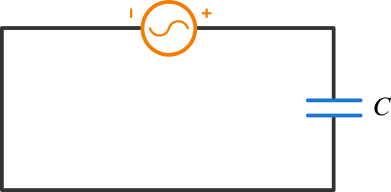📄 Print pdf
00971504825082
Alternating current part I
Capacitor and Inductor Circuit
Oscillation Circuit
When charging a capacitor, the capacitor gains stored electrical energy
due to the electric field
\[𝑈_𝐸 = \frac{{{1}}}{{{2}}} \frac{{{q^2}}}{{{C}}}\] and as a result of current passing through an inductor, it stores magnetic energy due to the magnetic field
\[P = ∆𝑉_{𝑖𝑛𝑑} . i = L\frac{{{di}}}{{{dt}}}i \]
\[𝑈_B =\int P . dt= \int L .i di= \frac{{{1}}}{{{2}}} L .i^2 \]
Question: How does an oscillation circuit work?



Physics Exam: Oscillation Circuit
Physics Exam: Capacitor and Inductor Circuit (Oscillation Circuit)
When charging a capacitor, the capacitor gains stored electrical energy due to the electric field. As a result of current passing through an inductor, it stores magnetic energy due to the magnetic field.
Question 1: What type of energy does a capacitor store when charged?
Question 2: What causes energy storage in an inductor?
Question 3: What is the circuit called that contains a capacitor and inductor?
Question 4: What happens to energy in an ideal oscillation circuit?
Question 5: What factor determines the oscillation frequency in the circuit?
Question 6: When energy in the capacitor is at maximum, what is it in the inductor?
Question 7: What happens if we add resistance to an oscillation circuit?
Question 8: When current in the circuit is at maximum, where is most energy concentrated?
Question 9: When voltage across the capacitor is at maximum in a circuit, what is the current in the circuit?
Question 10: In what practical application are oscillation circuits used?
AC Circuits
Useful Information: Operation of AC Circuits

Rotation of a coil in a magnetic field leads to the generation of induced emf given by the relation:
\[∆𝑉_{emf} =N. A.B.W Sin ( Wt) \]
AC Generator
\[𝑉_{max} =N. A.B.W \]
\[∆𝑉_{emf} =𝑉_m Sin ( Wt) \]
Thus, an induced current is produced that doesn't necessarily match the voltage in phase and varies in value every moment and direction every half cycle
\[I_{t} =I_m Sin ( Wt - ∅ ) \]
(∅) Phase angle between voltage and current
(I max) Maximum value of AC current called the amplitude of AC current
 AC Circuit Containing Ohmic Resistance
AC Circuit Containing Ohmic Resistance
In this simulation, an AC current is connected to an ohmic resistor and the voltage and current in the circuit are monitored
 Note that the current and voltage measurements change value every moment
The voltage and current will be represented as vectors
Note that the current and voltage measurements change value every moment
The voltage and current will be represented as vectors
Experiment Results
Impedance Calculation
Voltage and Current Equations
Phase Difference Between Current and Voltage
\[R = \frac{{{𝑉 (max)}}}{{{I (max)}}}\]\[R =\frac{{{𝑉(t)}}}{{{I(t)}}}\]
Voltage Equation \[V_R =𝑉_m Sin ( Wt) \]
 Graph of voltage and current over time
Graph of voltage and current over time
No relationship between frequency change and resistance
\[I_{t} =I_m Sin ( Wt) \]
 Current and voltage are in phase
Current and voltage are in phase
Example 1

Alternating current part I |
Capacitor and Inductor Circuit
When charging a capacitor, the capacitor gains stored electrical energy due to the electric field \[𝑈_𝐸 = \frac{{{1}}}{{{2}}} \frac{{{q^2}}}{{{C}}}\] and as a result of current passing through an inductor, it stores magnetic energy due to the magnetic field \[P = ∆𝑉_{𝑖𝑛𝑑} . i = L\frac{{{di}}}{{{dt}}}i \] \[𝑈_B =\int P . dt= \int L .i di= \frac{{{1}}}{{{2}}} L .i^2 \] Question: How does an oscillation circuit work?


Physics Exam: Capacitor and Inductor Circuit (Oscillation Circuit)
When charging a capacitor, the capacitor gains stored electrical energy due to the electric field. As a result of current passing through an inductor, it stores magnetic energy due to the magnetic field.
Question 1: What type of energy does a capacitor store when charged?
Question 2: What causes energy storage in an inductor?
Question 3: What is the circuit called that contains a capacitor and inductor?
Question 4: What happens to energy in an ideal oscillation circuit?
Question 5: What factor determines the oscillation frequency in the circuit?
Question 6: When energy in the capacitor is at maximum, what is it in the inductor?
Question 7: What happens if we add resistance to an oscillation circuit?
Question 8: When current in the circuit is at maximum, where is most energy concentrated?
Question 9: When voltage across the capacitor is at maximum in a circuit, what is the current in the circuit?
Question 10: In what practical application are oscillation circuits used?
Useful Information: Operation of AC Circuits

Rotation of a coil in a magnetic field leads to the generation of induced emf given by the relation:
\[∆𝑉_{emf} =N. A.B.W Sin ( Wt) \]
AC Generator
\[𝑉_{max} =N. A.B.W \]
\[∆𝑉_{emf} =𝑉_m Sin ( Wt) \]
Thus, an induced current is produced that doesn't necessarily match the voltage in phase and varies in value every moment and direction every half cycle
\[I_{t} =I_m Sin ( Wt - ∅ ) \]
(∅) Phase angle between voltage and current
(I max) Maximum value of AC current called the amplitude of AC current
In this simulation, an AC current is connected to an ohmic resistor and the voltage and current in the circuit are monitored
Experiment Results
Impedance Calculation Voltage and Current Equations Phase Difference Between Current and Voltage \[R = \frac{{{𝑉 (max)}}}{{{I (max)}}}\]\[R =\frac{{{𝑉(t)}}}{{{I(t)}}}\] Voltage Equation \[V_R =𝑉_m Sin ( Wt) \] No relationship between frequency change and resistance \[I_{t} =I_m Sin ( Wt) \]
AC Circuit Containing Ohmic Resistance







 Click here to show solution method
Click here to show solution method

 Graph of voltage and current over time
Graph of voltage and current over time Direct relationship
Direct relationship  Voltage leads current by 90 degrees
Voltage leads current by 90 degrees

 Graph of voltage and current over time
Graph of voltage and current over time Inverse relationship
Inverse relationship  Current leads voltage by 90 degrees
Current leads voltage by 90 degrees
0 Comments